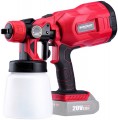Paint consumption
Consumption of paint or other material (for example, mortar for plaster) when the spray gun is operating in normal mode.
The higher the flow rate, the more material the tool can apply per unit of time, the better it is suitable for processing large areas and for applying thick coatings. On the other hand, not all types of work require high productivity, and sometimes relatively low consumption is optimal. Detailed recommendations on this subject for different situations can be found in special sources.
Maximum viscosity
The maximum viscosity of the paint or other working material at which the spray gun is able to work normally. Specified in DIN units; a certain DIN in this case is the number of seconds it takes for a standard volume of paint (usually 100 mL) to pour out of a funnel with a strictly defined pour hole diameter (usually about 4 mm). Such a funnel (viscometer) can be supplied with the spray gun, but if necessary, it can be purchased separately.
Thus, the larger the DIN, the more viscous the composition is. And the larger the number indicated in the characteristics of the spray gun, the wider its capabilities, the thicker liquids can be poured into it without fear of clogging and breakage. At the same time, it should be taken into account that in fact it is not so often necessary to work with thick liquids — on the contrary, excessive viscosity worsens the quality of the coating, leads to streaks and increases the drying time. For example, most enamels and oil paints are used at a viscosity of about 20 DIN, latex paints up to 45 DIN, etc. General recommendations on this matter can be found in special sources, and specific ones can be found on the packaging of a particular brand of paint or other composition.
Nozzle size
The diameter of the nozzle at the outlet of the spray gun.
It is from this nozzle that paint or other working material comes out. And the productivity and spot size at the exit depend on the diameter. Accordingly, larger nozzles are better suited for processing large surfaces, while smaller nozzles provide greater precision and accuracy. Thus, this parameter is directly related to the type of device (see above). There are also
spray guns with a replaceable nozzle, when more than one nozzle is provided in the kit, which expands the possibilities of using the device.
Container volume
The total volume of the paint reservoir supplied with the gun.
Large tank, on the one hand, allows you to "charge" a lot of material and work for a long time. On the other hand, it increases the size and weight of the device; and a large amount of paint will also weigh accordingly (although for models with a separate tank location - see above - this is not critical). Therefore, the thinner and more delicate the work for which the spray gun is designed, the, as a rule,
the smaller the tank volume : for example, in airbrushes (see "View") it rarely exceeds 50 ml, and in plaster models, in turn, can be measured liters. Therefore, most models have a volume of no more than a liter, namely
500 ml,
600 ml,
700 ml,
800 ml,
1000 ml.

